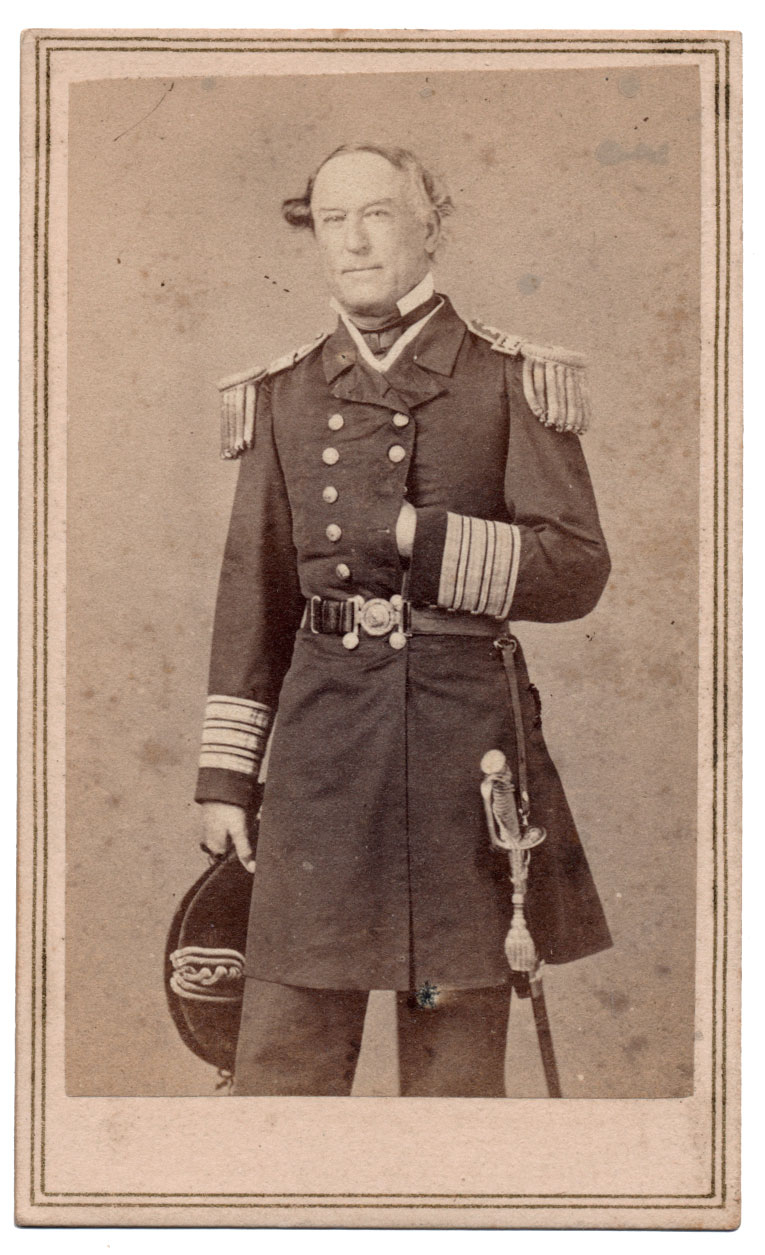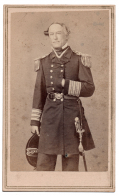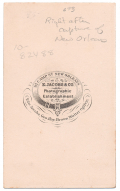site search
online catalog
CDV OF ADMIRAL DAVID GLASGOW FARRAGUT

$125.00 SOLD
Quantity Available: None
Item Code: 160-420
Three-quarter standing view of Farragut wearing a double-breasted dark frock coat with Admirals cuff braid and brush epaulettes and matching dark trousers. He also wears a plain black leather sword belt with Model 1852 Naval Officer’s sword attached. He is posed with one hand thrust in his coat and the other by his side holding a bi-corn.
Contrast and clarity are good. Paper and mount are in good condition.
Reverse has a photographer’s imprint for E. JACOBS & CO… NEW ORLEANS. There is also some collector information in modern pencil.
David G. Farragut was born July 5, 1801 to George Farragut, a native of Minorca, Spain, and his wife Elizabeth of North Carolina Scots-Irish American descent, at Lowe's Ferry on the Holston River in Tennessee.
In 1808, after his mother's death, David agreed to live with David Porter, a naval officer with whom he went to sea late in 1810. David Farragut grew up in a naval family, as the foster brother of future Civil War admiral, David Dixon Porter, and Commodore William D. Porter.
David Farragut's naval career began as a midshipman when he was nine years old, and continued for 60 years until his death at the age of 69.
Through the influence of his adoptive father, Farragut was commissioned a midshipman in the United States Navy on December 17, 1810, at the age of nine. A prize master by the age of 12, Farragut fought in the War of 1812, serving under Captain David Porter. While serving aboard USS Essex, Farragut participated in the capture of HMS Alert on August 13, 1812. He was wounded and captured while serving on the Essex during the engagement at Valparaiso Bay, Chile, against the British on March 28, 1814.
Farragut was promoted to lieutenant in 1822, during the operations against West Indian pirates.
In 1847, Farragut, now a commander, took command of the sloop-of-war USS Saratoga when she was recommissioned at Norfolk Navy Yard in Norfolk, Virginia. He served in the Gulf of Mexico until 31 January 1848, when Farragut took his ship to New York City, arriving there on 19 February. The Saratoga was decommissioned there on 26 February 1848.
In 1853 Commander David G. Farragut went to California to create the Mare Island Navy Yard near San Francisco. Captain Farragut commissioned Mare Island on July 16, 1858.
Though living in Norfolk, Virginia, prior to the Civil War, Farragut made it clear to all who knew him that he regarded secession as treason. Just before the war's outbreak, Farragut moved with his Virginian-born wife to Hastings-on-Hudson, a small town just outside New York City.
Offered a command by his foster brother, David Dixon Porter, the target was Farragut’s former childhood home of New Orleans.
Farragut was appointed under secret instructions on February 3, 1862, to command the Gulf Blockading Squadron, sailing from Hampton Roads on the screw steamer USS Hartford, which he made his flagship, accompanied by a fleet of 17 ships.
On April 18, Farragut ordered the mortar boats to commence bombardment on the forts defending the city inflicting considerable damage, but not enough to compel the Confederates into surrender. After two days of heavy bombardment, Farragut ran past forts Jackson and St. Philip and the Chalmette batteries to take the city and port of New Orleans on April 29, 1862.
Congress honored him by creating the rank of rear admiral on July 16, 1862, a rank never before used in the U.S. Navy. Before this time, the American Navy had resisted the rank of admiral, preferring the term "flag officer", to distinguish the rank from the traditions of the European navies.
Later that year, Farragut passed the batteries defending Vicksburg, Mississippi, but had no success there. A makeshift Confederate ironclad forced his flotilla of 38 ships to withdraw in July 1862.
Vicksburg surrendered on July 4, 1863, leaving Port Hudson as the last remaining Confederate stronghold on the Mississippi River. General Banks accepted the surrender of the Confederate garrison at Port Hudson on July 9, ending the longest siege in U.S. military history. Control of the Mississippi River was the centerpiece of the Union strategy to win the war, and, with the surrender of Port Hudson, the Confederacy was now cut in two.
On August 5, 1864, Farragut won a great victory in the Battle of Mobile Bay. The bay was heavily mined and when the monitor USS Tecumseh struck a mine and sank, the others began to pull back.
Farragut could see the ships pulling back from his high perch, where he was lashed to the rigging of his flagship, USS Hartford. "What's the trouble?", he shouted through a trumpet to USS Brooklyn. "Torpedoes", was the shouted reply. "Damn the torpedoes.", said Farragut, "Four bells, Captain Drayton, go ahead. Jouett, full speed." The bulk of the fleet succeeded in entering the bay. Farragut triumphed over the opposition of heavy batteries in Fort Morgan and Fort Gaines to defeat the squadron of Admiral Franklin Buchanan.
On December 21, 1864, Lincoln promoted Farragut to vice admiral. Farragut was promoted to full admiral on July 25, 1866, becoming the first U.S. Naval officer to hold that rank.
His last active service was in command of the European Squadron, from 1867 to 1868, with the screw frigate USS Franklin as his flagship. Farragut remained on active duty for life, an honor accorded to only seven other U.S. Naval officers after the Civil War.
Admiral Farragut died from a heart attack at the age of 69 in Portsmouth, New Hampshire, while on vacation in the late summer of 1870. He had served almost sixty years in the Navy. He is interred at Woodlawn Cemetery, in The Bronx, New York City. [ad][ph:L]
~~~~~~~~~~~~~~~~~~~~~~~~~~~~~~~~~~~
THIS ITEM, AS WITH ALL OTHER ITEMS AVAILABLE ON OUR WEB SITE,
MAY BE PURCHASED THROUGH OUR LAYAWAY PROGRAM.
CLICK HERE FOR OUR POLICIES AND TERMS.
THANK YOU!
Inquire About CDV OF ADMIRAL DAVID GLASGOW FARRAGUT
For inquiries, please email us at [email protected]
Most Popular
Historical Firearms Stolen From The National Civil War Museum In Harrisburg, Pa »
Theft From Gravesite Of Gen. John Reynolds »
Fine Condition Brass Infantry Bugle Insignia »
Selection Of Unframed Prints By Don Troiani »
Wonderful Condition Original Confederate-Manufactured Kepi For A Drummer Boy Or Child »
featured item
QUARTER-PLATE AMBROTYPE AND TWO LETTERS OF CONFEDERATE OFFICER RUNNELS DAVIS, WHO DIED OF WOUNDS RECEIVED AT THIRD WINCHESTER
Runnels Davis was born June 1, 1835. He was the first-born son of Alfred Ward Grayson Davis who was a roommate and third cousin, once removed, of future Confederate President Jefferson Davis at West Point. Alfred Davis left West Point before… (846-521). Learn More »




